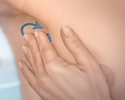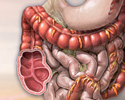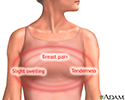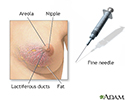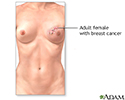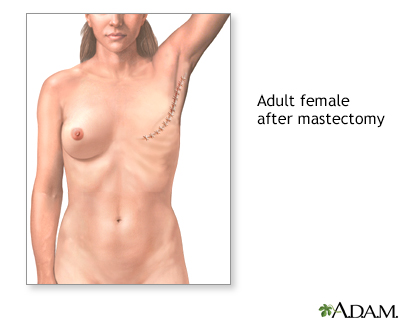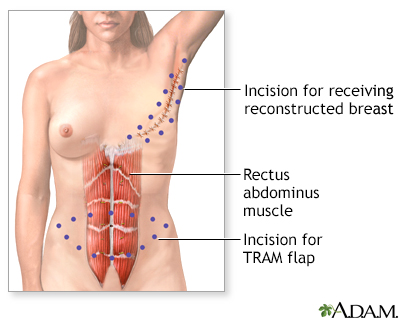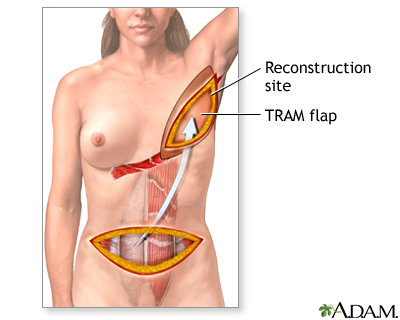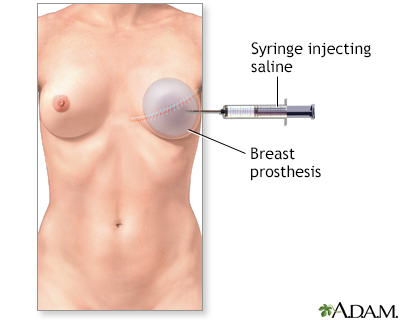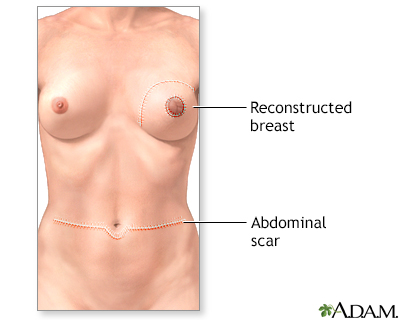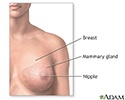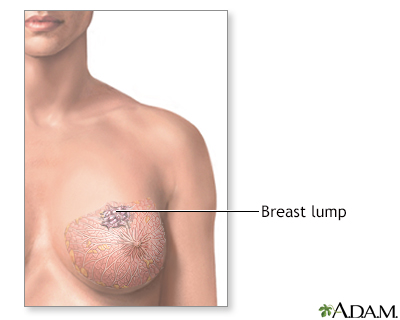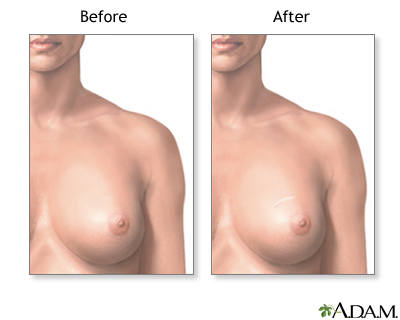Breast cancer
Cancer - breast; Carcinoma - ductal; Carcinoma - lobular; DCIS; LCIS; HER2-positive breast cancer; ER-positive breast cancer; Ductal carcinoma in situ; Lobular carcinoma in situBreast cancer is cancer that starts in the tissues of the breast. There are two main types of breast cancer:Ductal carcinoma starts in the tubes (ducts) that carry milk from the breast to the nipple. Most breast cancers are of this type. Lobular carcinoma starts in the parts of the breast, called lobules, which produce milk. In rare cases, other...
The Basics
Tests for Breast cancer
Talking to your MD
Breast cancer - Animation
Breast cancer
Animation
Breast self-exam - Animation
Breast self-exam
Animation
Colon cancer - Animation
Colon cancer
Animation
Breast pain
Breast pain can be due to many possible causes. Most likely breast pain is from hormonal fluctuations from menstruation, pregnancy, puberty, menopause, and breastfeeding. Breast pain can also be associated with fibrocystic breast disease, but it is a very unusual symptom of breast cancer.
Breast pain
illustration
Female breast biopsy
A breast biopsy can help diagnose breast cancer early in the disease process.
Female breast biopsy
illustration
Breast reconstruction - series
Presentation
Breast lump removal - series
Presentation
Breast cancer - Animation
Breast cancer
Animation
Breast self-exam - Animation
Breast self-exam
Animation
Colon cancer - Animation
Colon cancer
Animation
Breast pain
Breast pain can be due to many possible causes. Most likely breast pain is from hormonal fluctuations from menstruation, pregnancy, puberty, menopause, and breastfeeding. Breast pain can also be associated with fibrocystic breast disease, but it is a very unusual symptom of breast cancer.
Breast pain
illustration
Female breast biopsy
A breast biopsy can help diagnose breast cancer early in the disease process.
Female breast biopsy
illustration
Breast reconstruction - series
Presentation
Breast lump removal - series
Presentation
Breast cancer
Cancer - breast; Carcinoma - ductal; Carcinoma - lobular; DCIS; LCIS; HER2-positive breast cancer; ER-positive breast cancer; Ductal carcinoma in situ; Lobular carcinoma in situBreast cancer is cancer that starts in the tissues of the breast. There are two main types of breast cancer:Ductal carcinoma starts in the tubes (ducts) that carry milk from the breast to the nipple. Most breast cancers are of this type. Lobular carcinoma starts in the parts of the breast, called lobules, which produce milk. In rare cases, other...
The Basics
Tests for Breast cancer
Talking to your MD
Breast cancer
Cancer - breast; Carcinoma - ductal; Carcinoma - lobular; DCIS; LCIS; HER2-positive breast cancer; ER-positive breast cancer; Ductal carcinoma in situ; Lobular carcinoma in situBreast cancer is cancer that starts in the tissues of the breast. There are two main types of breast cancer:Ductal carcinoma starts in the tubes (ducts) that carry milk from the breast to the nipple. Most breast cancers are of this type. Lobular carcinoma starts in the parts of the breast, called lobules, which produce milk. In rare cases, other...
The Basics
Tests for Breast cancer
Talking to your MD
Review Date: 2/3/2025
Reviewed By: Warren Brenner, MD, Oncologist, Lynn Cancer Institute, Boca Raton, FL. Review provided by VeriMed Healthcare Network. Also reviewed by David C. Dugdale, MD, Medical Director, Brenda Conaway, Editorial Director, and the A.D.A.M. Editorial team.

